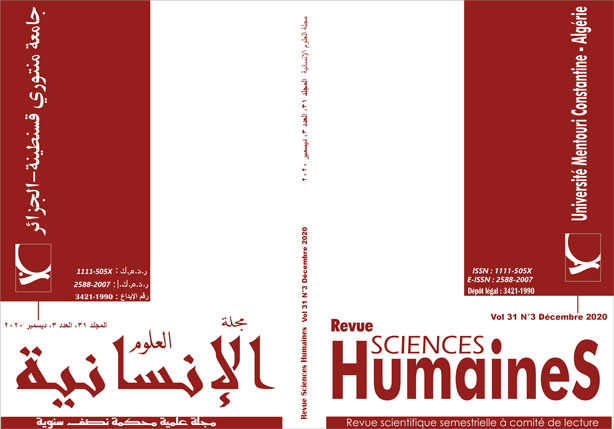Youthful french in the graphic novel: An authentic multimodal vector for language hybridization
Keywords:
Graphic novel, Authentic vector, Multimodality, Hybrid language, Social speechAbstract
In this study, we propose to examine the multimodal value of the graphic novel used in the teaching of foreign languages. To offer avenues likely to make the teaching / learning of young French more accessible, it is a question of highlighting the signs of language hybridization in this type of authentic multimodal supports, both in terms of visual, textual iconography or cultural. The deductions reveal the consequent potential of multidimensional exploitation which aims to bridge the gap between the classroom environment and the real life of the learners.
Downloads
References
. BLAND, J. (2013). Children’s Literature and Learner Empowerment. Children and Teenagers in English Language Education. [Kindle e-book]. Retrieved from http://amazon.com
. BOUMENDJEL, L. (2018). Le roman graphique : support pour développer l’oral chez les étudiants de Licence de français. Didactique. Université Frères Mentouri, Constantine 1.
. BULOT, Th. (2007). « Culture urbaine et diversité sociolinguistique : une identité en mouvement entre le local et le global ». Zongo Bernard. L’écho de ma langue (enjeux sociaux et culturels de la diversité des langues, TamTam59 / Confluence, pp. 31-37. Halshs-00608595 https://halshs.archives-ouvertes.fr/halshs-00608595/document
. CARY, S. (2004). Going Graphic: Comics at Work in the Multilingual Classroom. Portsmouth, NH: Heinemann.
. COPE, B & KALANTZIS, M. (2009). “Multiliteracies”: New Literacies, New Learning. Pedagogies: An International Journal, 4,3, 164-195. http://dx.doi.org.pva.uib.no/10.1080/15544800903076044
. EISNER, W. (2008). Graphic Storytelling and Visual Narrative. New York: W.W. Norton & Company Inc.
. ELSNER, D., VIEBROCK, B. (2013). Developing Multiliteracies in the 21st Century: Motives for New Approaches of Teaching and Learning Foreign Languages. In D. Elsner, S. Helff, B. Viebrock (Eds.), Film, Graphic Novels & Visuals. Developing Mulitliteracies in Foreign Language Education – An Interdisciplinary Approach (pp. 17-32). Berlin: LIT Verlag.
. FENNER, A.B. (2001). Dialogic Interaction with Literary Texts in the Lower Secondary Classroom. In Cultural Awareness and Language Awareness Based on Dialogic Interaction with Texts in Foreign Language Learners. (Ed.). European Centre for Modern Languages, Council of Europe Publishing.
. GAUSSEL, M. (2017). « Je Parle, Tu dis, Nous écoutons : Apprendre avec l’oral ». Dossier de veille de l’IFÉ, n°117, avril 2017. Lyon : ENS de Lyon. http://ife.ens-lyon.fr/vst/DA-Veille/117-avril-2017.pdf
. HEBERLE, V. (2010). Multimodal Literacy for Teenage EFL Students. Cadernos de Letras (UFRJ), 27, 101-116. Retrieved from http://www.letras.ufrj.br/anglo_germanicas/cadernos/numeros/122010/textos/cl301220 100viviane.pdf
. HOFF, H. E. (2013). ‘Self’ and ‘Other’ in meaningful interaction: using fiction to develop intercultural competence in the English classroom. Tidsskriftet FoU i praksis, 7(2), 27- 50. Retrieved from http://tapir.pdc.no/pdf/FOU/2013/2013-02-3.pdf
. KRESS, G. (2003). Literacy in the New Media Age. London: Routledge.
. MCCLOUD, S. (1993). Understanding Comics. New York: HarperCollins Publishers.
. RANKER, J. (2008). Using Comic Books as Read-Alouds: Insights on Reading Instruction from an English as a Second Language Classroom. The Reading Teacher, 61(4), 296-305. doi: 10.1598/RT.61.4.2
. RECINE, D. (2013). Comics Aren’t Just for Fun Anymore: The Practical Use of Comics by TESOL Professionals. (Master’s Thesis, University of Wisconson-River Falls, USA). Retrieved from https://core.ac.uk/display/10597902
. RICHARDSON, J. (2006). Analysing newspapers. An approach from critical discourse analysis. Basingstoke, UK : Palgrave Macmillan.
. ROYCE, T. D. (2007). Multimodal Communicative Competence in Second Language Contexts. In W. Bowcher & T.D. Royce (Eds.), New Directions in the Analysis of Multimodal Discourse. Mahwah: Lawrence Erlbaum Associates Inc.
. SERAFINI, F. (2015). Multimodal Literacy : From Theories to Practices. Language Arts, 92(6), 412-422. Retrieved from http://search.proquest.com/docview/1692493625?accountid=8579
. SKULSTAD, A.S. (2009). The Need for Rethinking Communicative Competence. In R. Krumsvik (Ed.), Learning in the Network Society and the Digitized School (pp. 255- 267). New York: Nova Science Publishers, Inc.
. VYGOTSKY, L.S. (1978). Mind in society: The development of higher psychological processes. Cambridge, MA: Harvard University Press.
. WEAVER, S. (2011). The rhetoric of racist humour. US, UKand global race joking. Farnham : Ashgate Publishing.
Note :
. Différents registres de langue des deux codes (écrit et oral).
. Par la dénomination « français jeune » emprunté à Bulot, il est question ici d’un français utilisé dans les différentes situations de communication, dans un monde actuel en permanente évolution (Que ce soit en classe de langue, en dehors d’une institution scolaire ou sur les réseaux sociaux, etc.)
. Bulot, Th. (2007).
. Lilia BOUMENDJEL (2018).
. Coiffure de plusieurs peuples, associée en particulier au mouvement « Rastafari ».
. Expression que nous avons choisie pour désigner l’immensité des connaissances et des cultures renfermées dans le roman graphique.
. Boumendjel, L. (2018).
Downloads
Published
How to Cite
Issue
Section
License

This work is licensed under a Creative Commons Attribution-NonCommercial-ShareAlike 4.0 International License.
















